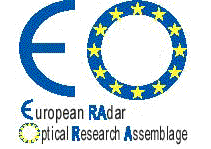
European RAdar-Optical Research Assemblage (ERA-ORA)

ERA-ORA is a Concerted Action funded
by the European Commission within the RTD Programme on Environment and
Climate (Fourth Framework Programme) in the field of space techniques applied
to environmental monitoring and research.
Institutions from eight European
Countries and an international organisation take part in the project:
| CESBIO/Université Paul Sabatier, Toulouse, France (T. Le Toan) | |
| DLR, Oberpfaffenhofen, Germany (C. Schmullius, D. Hounam) | |
| ESA/ESTEC, Noordwijk, Netherlands (M. Borgeaud) | |
| Gamma A.G., Muri, Switzerland (T. Strozzi) | |
| Landbouwuniversiteit Wageningen, Netherlands (D. Hoekman) | |
| Universitat de Valencia, Spain (J. Moreno) | |
| Università Tor Vergata, Roma, Italy (D. Solimini, coordinator) | |
| Université Catholique de Louvain, Belgium (A. Guissard) | |
| University of Sheffield, Great Britain (S. Quegan) |
Essential objective of the Concerted Action:
To improve the radar data analysis and utilization tools
developed by European researchers for Earth observation from space.
Motivation:
Radar is sensitive to environmental parameters, like
soil moisture and roughness, vegetation type and biomass, snow water equivalent,
etc. However, the full exploitation of radar potential in environmental
applications has been hindered by the fragmentation and particularization
of model and application tools and by the restricted amount of experimental
data at the disposal of a single researcher.
Action:
A pool of European researchers have put in common radar
data (with corresponding ground truth) and the possibly available simultaneous
optical/IR measurements, and computer programs for theoretical backscattering
modeling. The ensemble of data and software forms the ERA-ORA Library.
The Library data and software can be employed in
different applications.
Content of the Library:
One section of the Library includes radar data taken
over land (bare soil, crops, forest and snow-covered terrain) for several
sites in Europe.
For some sites, also simultaneous optical/IR reflectances
are available.
Radar signatures and optical reflectances are usually
accompanied by significant ground data (soil moisture and roughness, vegetation
biomass, leaf area index, snow water equivalent, etc.).
A second section of the Library assembles theoretical models for backscattering simulation.
The report gives details on data
and models, discusses selected applications of the Library to agriculture
and contains suggestions and recommendations.
A handbook,
in the form of a html document, describes the database structure and the
guidelines followed by each partner to fill it.
Use of the Library:
A coordinated use of data and models stored in the Library
is encouraged towards the following objectives: